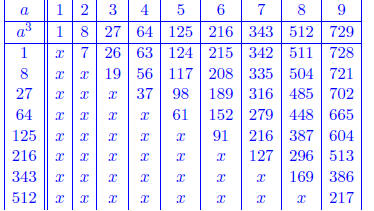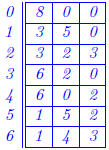Discrete Structure Homework: Logic II
1. (10) (1.6: 6) Use a direct proof to show that the
product of two odd integers is
odd.
Let a, b be odd integers. Then we can write a = 2x + 1 and b = 2y + 1 for
some integers x, y. Multiplying a and b gives:
ab = (2x + 1)(2y + 1)
= 4xy + 2(x + y) + 1
= 2(2xy + x + y) + 1
Therefore the product of two odd integers is odd.
2. (1.6: 12) Prove or disprove that the product of a nonzero rational number and
an irrational number is irrational.
By contradiction: Let x ∈ Q \ {0} and y ∈ R \ Q. Assume that xy = z ∈ Q.
Then there exists a, b, c, d ∈ Z such that  Then
Then
xy = z
y = zx-1

 y ∈ Q
y ∈ Q
Since y ∈ R\Q, this contradicts our assumption and the
product of a nonzero
rational number and and irrational number is irrational.
3. (1.6: 16) Prove that if m and n are integers and mn is even then m is even or
n
is even.
Proof by contradiction: Assume both m and n are odd and mn
is even. Then
from the definition of odd integers there exists
 ∈ Z such that
∈ Z such that

and  . Then
. Then  ,
which is an odd integer.
,
which is an odd integer.
Since mn is even, this contradicts our assumption and at least one of m or n
is even.
4. (1.6: 20)Prove the proposition P(1), where P(n) is the proposition “If n is a
positive integer, then n2 ≥ n”. What kind of proof did you use?
P(1) states that 12 ≥ 1. Since 12 = 1, P(1) is true.
Direct proof.
5. (15) (1.6: 28) Prove the m2 = n2 if and only if m = n
or m = -n.
If m = n or m = -n, then m2 = (±n)2 = n2. If m2
= n2, then
0 = m2 - n2
= (m - n)(m + n)
Since ab = 0 if and only if a = 0 or b = 0, therefore either m - n = 0, and
m = n or m + n = 0, and m = -n. (NOTE: poorly worded problem as it
doesn't state the domain of m, n. If m, n ∈ ,
for example, and m = 2, n = 6,
,
for example, and m = 2, n = 6,
then m2 ≡ 4 mod 8 and n2 = 36 = 8(4) + 4 ≡ 4 mod 8)
6. (1.7: 2) Prove that there are no positive perfect cubes less than 1000 that
are
the sum of the cubes of two positive integers.

Proof by exhaustion: The only possible values for a, b, c
are the integers
1, 2, . . . , 9. The table below gives a, a3, then c3-a3,
for all c, a pairs whose result
is greater than zero. None of these produces a perfect cube (b3),
therefore
no a, b, c ∈ Z, a, b, c > 0 exists with a3 + b3 = c3
and c < 1000.

7. (10) (1.7: 6) Prove that there is a positive integer
that equals the sum of the positive
integers not exceeding it. Is the prove constructive or non-constructive.
1 = 1, therefore this hypothesis is true. This is a constructive proof.
8. (1.7: 8) Prove that either (2 × 10500 + 15) or (2 × 10500 + 16) is not a
perfect
square. Is the proof constructive or non-constructive.
Proof by contradiction: Let a = 2 × 10500 + 15 and b = a + 1. Assume
both a, b are perfect squares  a = x2, b = y2. Therefore
a = x2, b = y2. Therefore
b - a = y2 - x2 = 1. But y2 - x2 = (y - x)(y + x) = 1, and y - x, y + x ∈ Z.
Therefore y - x = y + x and equals either 1 or -1. But this implies that
-x = x or x = 0, a = 0 which contradicts the definition of a. Therefore both
a and b are not perfect squares
9. (1.7: 12) Prove or disprove that if a, b ∈ Q, then ab ∈ Q.
Proof by counter example: Let a = 2,  . We know that
. We know that
 , therefore
, therefore
a, b ∈ Q does not imply that ab ∈ Q.
10. (1.7: 14) Show that if a, b, c ∈ R and a ≠ 0, then there is a unique
solution x
of the equation ax + b = c.
Direct proof: Since a ≠ 0,
 , and x = (c-b)a-1. If x ∈ R is a solution
, and x = (c-b)a-1. If x ∈ R is a solution
to ax + b = c, then ax = c - b and x = (c - b)/a, therefore the solution is
unique.
11. (15) (1.7: 28) Prove that there are no solutions x, y ∈ Z to the equation
2x2 +
5y2 = 14.
Proof by contradiction: If x, y ∈ Z and 2x2 + 5y2 = 14 then WLOG we can
assume x, y ≥ 0. We also know x, y ≠ 0 since no x or y exists such that
2x2 = 14 or 5y2 = 14. Thus 0 < x < 3 and 0 < y < 2, and y = 1. This
implies 2x2 = 14 - 5 = 9. But 9 is odd and 2x2 is even, therefore no x, y ∈ Z
exist 5y2 = 14 - 2x2.
12. (1.7: 36) Prove or disprove that if you have an 8 gallon jug (8G) of water
and
a 5G and 3G empty jugs, then you can measure 4G by successively pouring
some of or all of the water in one jug into another.
 |
Start |
| Pour 5g from 8G to 5G | |
| Pour 3g from 5G to 3G | |
| Pour 3g from 3G to 8G | |
| Pour 2g from 5G to 3G | |
| Pour 5g from 8G to 5G | |
| Pour 1g from 5G to 3G |


